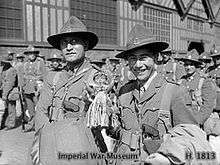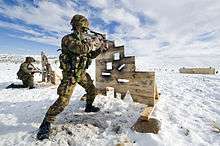Uniforms of the New Zealand Army
The New Zealand Army uniform has changed over the years from that of the original Armed Constabulary to the modern day NZDPM uniform. While British Army influence has always been strong, distinctive New Zealand features have gradually developed, notably in the form of headdresses.
Uniforms of the New Zealand Wars
During the New Zealand Wars of 1846–1886, settler militia and Maori allies in a variety of clothing styles served alongside the British Imperial forces who wore their red and blue undress uniforms until plain dark blue field uniforms were adopted after 1860. In the later stages of the Land Wars a locally recruited force designated as the Armed Constabulary replaced the British regular regiments. The Armed Constabulary, the forerunner of both the NZ Army and the New Zealand Police, wore a blue woollen uniform with a red stripe down the trouser seam and a kepi-like headdress. In the field this was often worn with a kilt or Māori Piupiu for convenience in wading across streams and rivers.
Boer War uniforms
The New Zealand contingent serving in South Africa from 1899–1902 sometimes wore the British pith helmet with standard khaki drill uniform and puttees. The usual headdress however was the Australian style slouch hat, worn at this stage in its history without the turned-up brim. The New Zealand and other colonial contingents in this war affected a more casual dress style than the more strictly disciplined British regulars.
Volunteers and Territorial Army
The various volunteer militia units in existence until 1910 wore a variety of scarlet, dark blue or rifle-green dress uniforms, generally closely following contemporary British Army patterns. Some units, recruited in coastal areas, favored Royal Navy style dress. Since 1902 a khaki serge service uniform had been general issue. The regional regiments of the new Territorial Army, which replaced the militia, wore the universal "1912 Uniform" of khaki in a greenish/brown shade, worn with a slouch hat. Officers frequently wore the peaked cap of the British Army. Units were distinguished by regimental badges attached to the turned up brim of the hat; and branches by colored piping on tunic shoulder straps and trouser seams. Dark blue dress uniforms were authorised for officers and members of the small Permanent Staff (regular cadre).
World War I uniforms
During the Gallipoli campaign New Zealand troops wore a variety of hot-weather khaki drill uniforms with either slouch hats or the peaked cap of the British Army. Supply difficulties and the harsh nature of terrain and climate during this campaign meant that little emphasis was placed on smartness or uniformity of dress.
When in France the 1st New Zealand Expeditionary Force wore khaki uniforms of British style together with the distinctive "lemon squeezer" campaign hat, which prior to 1914 had been worn by only one regiment. The uniforms worn on the Western Front included a mounted service pattern greatcoat, the Brodie helmet when in combat, and the universal combat boots and puttees wrapped around the legs
Inter-war period
The reduced peace-time New Zealand forces of the period 1920-39 retained what was essentially a smartened version of the Western Front uniform of 1916-18. Puttees however were replaced by short anklets during the 1930s and a dark-blue dress uniform was approved in 1938 to encourage voluntary recruiting for Territorial units. Only bands resumed the scarlet parade uniforms of the pre-1910 Volunteer era. The lemon squeezer with a wide range of coloured "pugaree" hat-bands to distinguish branches and units was retained in most orders of dress. Until mechanization, the Mounted Rifles regiments wore their own version of the slouch hat, with a green pugaree.
World War II uniforms
During the earlier stages of the War the 2nd New Zealand Expeditionary Force wore the traditional lemon squeezer hat with the universal NZ Badge. A high collared khaki service uniform, drawn from peace-time issue, was soon replaced by British style battle dress or in North Africa, by light khaki drill short-sleeved shirts and shorts. In combat the Brodie helmet was also worn. The lemon squeezer hat with its conspicuous coloured pugarees and wide rigid brim was largely replaced by more practical forage caps and berets during the Italian Campaign of 1943-44.

Malayan conflict,Vietnam uniforms
British-pattern Battle Dress was worn until the 1960s, with "Jungle Greens" being used as field wear with Beret or Khaki Cap and Boonie hat (usually called a J hat).
Current uniforms

New Zealand Army uniforms have historically followed the British pattern of the British Army Uniform with the high crowned "lemon squeezer" hat as the most visible national distinction. In 2012 it was announced that the MRH (Mounted Rifles Hat) was to become the standard Army ceremonial headdress with the lemon squeezer being retained only for colour parties and other limited categories.[1]
General trends over the past two decades have included the appearance of distinctive New Zealand features in details such as ceremonial headdresses and sergeants' sashes (now dark blue instead of British Army red), combined with the reduction of corps and regimental distinctions in favor of standardised army-wide patterns. As examples of the latter, a universal rifle-green beret is now worn and a standard scarlet and blue mess uniform for officers and senior NCOs has replaced the varied colours and facings formerly in use. Scarlet and blue full dress uniforms of slightly differing patterns are worn by both the New Zealand Army Band and the Officer Cadet School, together with lemon squeezer hats respectively in khaki or dark blue.
US-style M1 steel helmets were the standard helmet from 1960-2000 which were replaced by the US PASGT helmet until 2009 after which the Australian Enhanced Combat Helmet became the standard issue helmet.
British DPM was adopted in 1980 as the camouflage pattern for clothing, the colours of which were further modified several times to better suit New Zealand conditions. This evolved pattern is now officially referred to as New Zealand disruptive pattern material and is almost identical to Dutch DPM but without the dithering. In the 2000's a desert DPM pattern, also based on the British pattern was in use with New Zealand peacekeeping forces in Iraq and Afghanistan. NZ SAS soldiers serving in Afghanistan were issued with Australian-sourced uniforms in MultiCam camouflage. NZDPM and NZDDPM were replaced in 2013 by the New Zealand Multi Terrain Camouflage Uniform (MCU) for all branches of NZDF. The MCU brings the New Zealand uniform more in line with the style of the Army Combat Uniform originating with and popularized by the United States and widely adopted internationally.
References
- ↑ Fairfax NZ News 3 May 2012